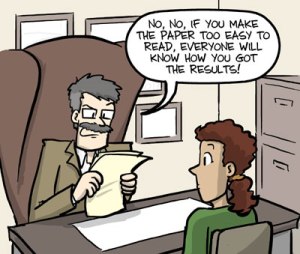Reading and understanding research papers is a skill that every single doctor and scientist has had to learn during graduate school. You can learn it too, but like any skill it takes patience and practice. First, it’s important to form a truly educated opinion on a scientific subject of interest and become familiar with current research in that field. This is the beginning, before being able to distinguish between good and bad interpretations of any research, on any topic.
Reading your first couple of papers may take a very long time, but be patient with yourself. The process will go much faster as you gain experience. Reading a scientific paper is a completely different process from reading an article about science in a blog or newspaper. Be prepared to take notes and re-read. Primary research is the main focus here; each article is a peer-reviewed report of new research on a specific question (or questions) in that field. They are typically published in a well-regarded journal in that field. Most articles will be divided into the following sections: Abstract, Introduction, Methods, Results, and one or more Discussion/Conclusions/Interpretation.
This article has a nice 11-step process How to Read and Understand a Scientific Paper: A Step-by-Step Guide for Non-Scientists. The author, Dr. Jennifer Raff worked it into a convenient .pdf, here How to read and understand a scientific article.
Importantly, this is not the only method to determine the validity and rigor of peer-reviewed science. We now have Retraction Watch; a site developed by science and medicine reporters that is gathering and evaluating the science papers that have been retracted from the journals (or experienced other negative actions) in which they were published. Until this site, there was previously no central repository of such things. They are working on a searchable database, but building that takes time.
Additionally, they are advocating for a Transparency Index which takes on a number of the review concepts described by Dr. Raff. I, personally, hope this leads to a ‘draft standard’ for the entire science community that is adopted and enforced by all journals. One can dream…
In the meantime, here are the basic steps for reading a journal article (credit to Dr. Raff). You might want to make yourself a nice hot beverage before digging in.
1) Read the Introduction first, not the Abstract.
2) Identify what problem is this entire field trying to solve; this is also known as The Big Question.
3) Try and summarize the Background in 5 sentences, or less.
4) Identify the specific questions being asked.
5) What is the approach (what are they going to do)?
6) What Methods are they using? (Diagram the experiments in your notes)
7) Read the Results. Then summarize the results for each experiment, figure, and table for yourself.
8) Do the Results answer the Big Question? Or at least some of the problems underlying that question?
9) From the Conclusion/Discussion/Interpretation section(s), what do the authors think the results mean? Do you agree?
10) Now read the Abstract. Does it match the contents of the paper? Does it fit with your interpretation?
11) What do other researchers say about the paper? Look for the experts in the field. Now is a time to use Google. And, I will add, Retraction Watch. Is there commentary on this paper? How about the authors; do they have retractions for other papers they have written?
Note: Not all retractions are equal. Some can be as simple as minor miscalculations, errors in labeling images, mis-attribution. Others are very serious cases; like fraud, data fabrication, plagiarism.
Other resources:
The Non-Scientist’s Guide to Reading and Understanding a Scientific Paper (Elysium Health)
Checking the source: how to read a scientific paper (Cosmos)
How to Read a Scientific Paper (WikiHow)
How to read a scientific paper (ScienceMag – AAAS)
Infographic: How to read a scientific paper (Elsevier)
How do expert readers approach a scientific paper? (Kenyon College)
How to read a scientific paper (YouTube slide presentation)

